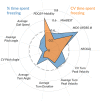Measuring freezing of gait during daily-life: an open-source, wearable sensors approach
- PMID: 33397401
- PMCID: PMC7784003
- DOI: 10.1186/s12984-020-00774-3
Measuring freezing of gait during daily-life: an open-source, wearable sensors approach
Abstract
Background: Although a growing number of studies focus on the measurement and detection of freezing of gait (FoG) in laboratory settings, only a few studies have attempted to measure FoG during daily life with body-worn sensors. Here, we presented a novel algorithm to detect FoG in a group of people with Parkinson's disease (PD) in the laboratory (Study I) and extended the algorithm in a second cohort of people with PD at home during daily life (Study II).
Methods: In Study I, we described of our novel FoG detection algorithm based on five inertial sensors attached to the feet, shins and lumbar region while walking in 40 participants with PD. We compared the performance of the algorithm with two expert clinical raters who scored the number of FoG episodes from video recordings of walking and turning based on duration of the episodes: very short (< 1 s), short (2-5 s), and long (> 5 s). In Study II, a different cohort of 48 people with PD (with and without FoG) wore 3 wearable sensors on their feet and lumbar region for 7 days. Our primary outcome measures for freezing were the % time spent freezing and its variability.
Results: We showed moderate to good agreement in the number of FoG episodes detected in the laboratory (Study I) between clinical raters and the algorithm (if wearable sensors were placed on the feet) for short and long FoG episodes, but not for very short FoG episodes. When extending this methodology to unsupervised home monitoring (Study II), we found that percent time spent freezing and the variability of time spent freezing differentiated between people with and without FoG (p < 0.05), and that short FoG episodes account for 69% of the total FoG episodes.
Conclusion: Our findings showed that objective measures of freezing in PD using inertial sensors on the feet in the laboratory are matching well with clinical scores. Although results found during daily life are promising, they need to be validated. Objective measures of FoG with wearable technology during community-living would be useful for managing this distressing feature of mobility disability in PD.
Keywords: Freezing of Gait Questionnaire; Freezing of gait; Home monitoring; Parkinson’s disease; Wearable sensors.
Conflict of interest statement
Dr. Horak have a significant financial interest in APDM, a company that may have a commercial interest in the results of this research and technology. Dr. Horak also consults for Biogen, Neuropore, Sanofi, and Takeda. This potential individual conflict has been reviewed and managed by OHSU.
Figures





References
-
- Morris ME, Huxham FE, McGinley J, Iansek R. Gait disorders and gait rehabilitation in Parkinson's disease. Adv Neurol. 2001;87:347–361. - PubMed
Publication types
MeSH terms
Grants and funding
LinkOut - more resources
Full Text Sources
Other Literature Sources
Medical

